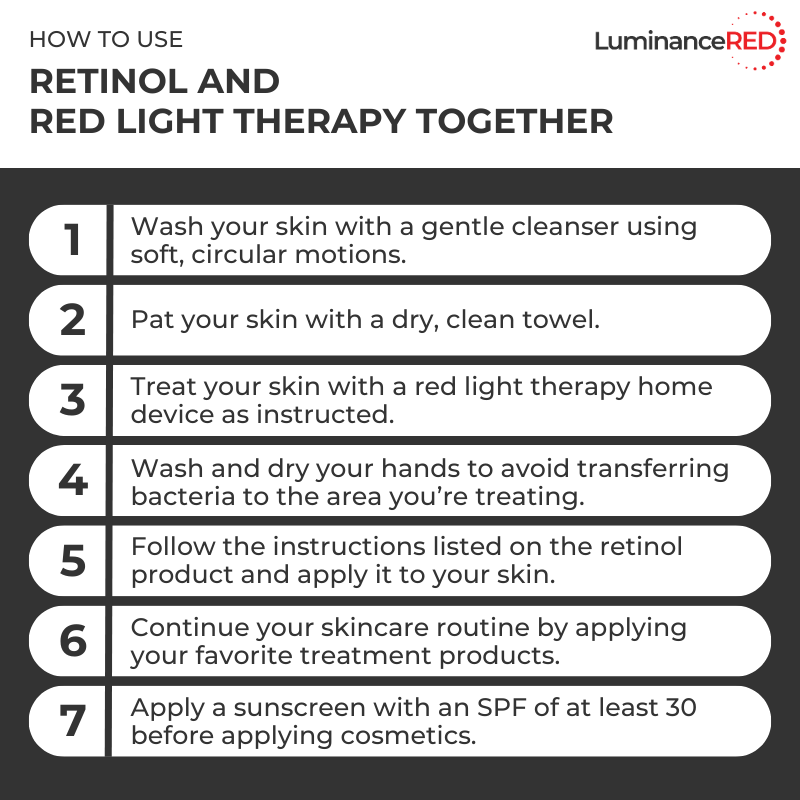In the ever-evolving world of skincare, various therapies and treatments vie for attention. Among these, retinol and red light therapy have gained considerable acclaim for their abilities to rejuvenate the skin. However, the question of whether these two powerhouses can be used in tandem frequently arises. In this article, we delve into the intricacies of retinol and red light therapy, examining their individual benefits, mechanisms, and the potential compatibility of combining these two treatments.
Retinol, a derivative of vitamin A, is renowned for its efficacy in promoting skin cell turnover. It enhances the skin’s natural process of exfoliation, thus helping to improve the appearance of fine lines, wrinkles, and pigmentation issues. As a cell-communicating ingredient, retinol effectively signals skin cells to behave in a more youthful manner, encouraging the production of collagen and elastin.
On the other hand, red light therapy, also known as low-level laser therapy (LLLT), utilizes specific wavelengths of light to penetrate the skin. This non-invasive treatment stimulates cellular function, promotes healing, and enhances overall skin texture. Red light therapy is particularly beneficial for reducing inflammation, speeding up recovery from skin blemishes and brightening complexion.
Both retinol and red light therapy focus on cellular renewal and rejuvenation, albeit through different mechanisms. The former relies on biochemical pathways, while the latter employs photobiomodulation—a process where specific wavelengths of light positively impact mitochondrial function, ultimately resulting in increased ATP production. But the question remains: can these two treatments effectively coexist in a skincare regimen?
While there are compelling arguments in favor of using retinol and red light therapy together, it’s essential to approach this combination with caution. Retinol can increase skin sensitivity, particularly during initial use or when applied in higher concentrations. This heightened sensitivity may lead to irritation, redness, or peeling. Conversely, red light therapy tends to soothe and reduce inflammation, which can potentially counterbalance some of the irritation caused by retinol. Thus, the pairing could conceivably yield enhanced benefits while mitigating undesirable side effects.
When contemplating a dual approach, understanding the proper timing and application becomes paramount. Users can adopt a staggered routine, applying retinol on one night and following with red light therapy shortly thereafter. This method allows the skin to acclimate to the potency of retinol without overwhelming it. Alternatively, some experts advocate for applying retinol in the morning, followed by red light therapy treatment in the evening. Such a regimen could allow the skin ample time to recover and benefit from both protocols.
Additionally, the type of retinol product selected can influence the efficacy of this combination. Products with slower-release formulas may deter skin irritation, making it a suitable candidate for those undertaking red light therapy. A lower concentration of retinol might also be ideal for those prone to sensitivity, ensuring a harmonious blend of treatments.
Another pertinent consideration is the duration and frequency of each treatment. Red light therapy sessions typically range from 10 to 20 minutes, with recommendations often suggesting two to three sessions weekly. For retinol, a focus on gradual incorporation—beginning with two to three times per week—can pave the way for increased tolerance while maximizing results.
Skin type also plays a pivotal role in determining compatibility. Individuals with oily or acne-prone skin may find retinol and red light therapy to be a powerful tandem for combating breakouts and minimizing pore size. However, those with delicate or sensitive skin should exercise caution and consult a dermatologist before introducing such treatments into their routine, as they might exacerbate existing irritations or conditions.
Moreover, combining these two treatments can help maximize results if accompanied by a robust skincare routine. Incorporating hydrating serums, soothing botanicals, and broad-spectrum sunscreen can create an effective regimen that supports the skin’s barrier function. While retinol works diligently to enhance cell turnover, red light therapy can further replenish and revive dull or damaged skin.
It’s crucial to listen to your skin when experimenting with new combinations. Monitor reactions closely. If experiencing excessive sensitivity or irritation, it may be wise to scale back on either treatment or consult a skincare specialist. Finding the right balance is key, as every individual’s skin is uniquely reactive.
With ongoing research into the synergy of modern skincare treatments, retinol and red light therapy continue to show promise when used carefully. These treatments are not necessarily mutually exclusive; rather, they can coexist to amplify their shared goal—skin rejuvenation. By utilizing tailored strategies and understanding skin responses, many individuals can embrace the transformative effects of both retinol and red light therapy.
In conclusion, blending retinol with red light therapy is a nuanced endeavor that can yield rewarding results if done thoughtfully. The interplay between the two highlights the dynamic nature of skincare, inviting users to explore the combined benefits of these increasingly popular modalities. As always, maintaining an informed approach and prioritizing skin health will pave the way for continued progress in your skincare journey.
